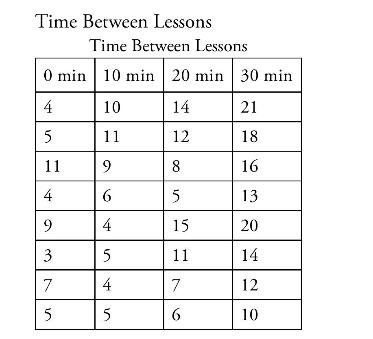A researcher studying the effects of different learning techniques upon memory hypothesizes people learn better when training
Question:
A researcher studying the effects of different learning techniques upon memory hypothesizes people learn better when training is distributed over time rather than massed all at once. She conducts an experiment in which 32 participants are randomly assigned to one of four conditions. Giving each subject several lessons to learn, she systematically varies the period of time between each lesson: 0 minutes between lessons (a massed learning condition), 10 minutes, 20 minutes, or 30 minutes. After the participants receive all of the lessons, they complete a 25 -item test measuring comprehension of the material. Their scores on the test are given belowconduct a one-way ANOVA on these data.

a. Calculate the sample size \(\left(N_{i}\right)\), mean \(\left(\mathrm{X}^{-} \mathrm{i}\right)\), and standard deviation \(\left(s_{i}\right)\) for each group.
b. State the null and alternative hypotheses \(\left(\mathrm{H}_{0}\right.\) and \(\left.\mathrm{H}_{1}\right)\).
c. Make a decision about the null hypothesis.
1, Calculate the degrees of freedom \((d f)\).
2, Set alpha (a), identify the critical value, and state a decision rule.
3, Calculate the \(F\)-ratio \((F)\) and create an ANOVA summary table.
4, Make a decision whether to reject the null hypothesis.
5, Determine the level of significance.
6, Calculate a measure of effect size \(\left(R^{2}\right)\).
d. Draw a conclusion from the analysis.
e. Relate the result of the analysis to the research hypothesis.
Step by Step Answer:

Fundamental Statistics For The Social And Behavioral Sciences
ISBN: 9781483318790
1st Edition
Authors: Howard T. Tokunaga





